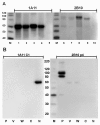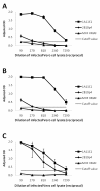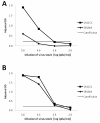Use of monoclonal antibodies against Hendra and Nipah viruses in an antigen capture ELISA
- PMID: 20525276
- PMCID: PMC2896928
- DOI: 10.1186/1743-422X-7-115
Use of monoclonal antibodies against Hendra and Nipah viruses in an antigen capture ELISA
Abstract
Background: Outbreaks of Hendra (HeV) and Nipah (NiV) viruses have been reported starting in 1994 and 1998, respectively. Both viruses are capable of causing fatal disease in humans and effecting great economical loss in the livestock industry.
Results: Through screening of hybridomas derived from mice immunized with gamma-irradiated Nipah virus, we identified two secreted antibodies; one reactive with the nucleocapsid (N) protein and the other, the phosphoprotein (P) of henipaviruses. Epitope mapping and protein sequence alignments between NiV and HeV suggest the last 14 amino acids of the carboxyl terminus of the N protein is the target of the anti-N antibody. The anti-P antibody recognizes an epitope in the amino-terminal half of P protein. These monoclonal antibodies were used to develop two antigen capture ELISAs, one for virus detection and the other for differentiation between NiV and HeV. The lower limit of detection of the capture assay with both monoclonal antibodies was 400 pfu. The anti-N antibody was used to successfully detect NiV in a lung tissue suspension from an infected pig.
Conclusion: The antigen capture ELISA developed is potentially affordable tool to provide rapid detection and differentiation between the henipaviruses.
Figures





Similar articles
-
Enzyme-Linked Immunosorbent Assay Using Henipavirus-Receptor EphrinB2 and Monoclonal Antibodies for Detecting Nipah and Hendra Viruses.Viruses. 2024 May 16;16(5):794. doi: 10.3390/v16050794. Viruses. 2024. PMID: 38793674 Free PMC article.
-
Indirect ELISA based on Hendra and Nipah virus proteins for the detection of henipavirus specific antibodies in pigs.PLoS One. 2018 Apr 30;13(4):e0194385. doi: 10.1371/journal.pone.0194385. eCollection 2018. PLoS One. 2018. PMID: 29708971 Free PMC article.
-
Monoclonal antibodies against the nucleocapsid proteins of henipaviruses: production, epitope mapping and application in immunohistochemistry.Arch Virol. 2008;153(2):273-81. doi: 10.1007/s00705-007-1079-x. Epub 2007 Nov 5. Arch Virol. 2008. PMID: 17978885
-
A treatment for and vaccine against the deadly Hendra and Nipah viruses.Antiviral Res. 2013 Oct;100(1):8-13. doi: 10.1016/j.antiviral.2013.06.012. Epub 2013 Jul 6. Antiviral Res. 2013. PMID: 23838047 Free PMC article. Review.
-
A Comparative Assessment of the Pathogenic Potential of Newly Discovered Henipaviruses.Pathogens. 2024 Jul 16;13(7):587. doi: 10.3390/pathogens13070587. Pathogens. 2024. PMID: 39057814 Free PMC article. Review.
Cited by
-
Development, characterization and application of monoclonal antibodies against Brazilian Dengue virus isolates.PLoS One. 2014 Nov 20;9(11):e110620. doi: 10.1371/journal.pone.0110620. eCollection 2014. PLoS One. 2014. PMID: 25412181 Free PMC article.
-
Enzyme-Linked Immunosorbent Assay Using Henipavirus-Receptor EphrinB2 and Monoclonal Antibodies for Detecting Nipah and Hendra Viruses.Viruses. 2024 May 16;16(5):794. doi: 10.3390/v16050794. Viruses. 2024. PMID: 38793674 Free PMC article.
-
Nipah Virus: A Zoonotic Threat Re-Emerging in the Wake of Global Public Health Challenges.Microorganisms. 2025 Jan 9;13(1):124. doi: 10.3390/microorganisms13010124. Microorganisms. 2025. PMID: 39858892 Free PMC article. Review.
-
Elucidation and clinical role of emerging viral respiratory tract infections in children.Adv Exp Med Biol. 2013;764:191-204. doi: 10.1007/978-1-4614-4726-9_16. Adv Exp Med Biol. 2013. PMID: 23654068 Free PMC article. Review.
-
Evaluation of three rapid low-resource molecular tests for Nipah virus.Front Microbiol. 2023 Feb 9;13:1101914. doi: 10.3389/fmicb.2022.1101914. eCollection 2022. Front Microbiol. 2023. PMID: 36845977 Free PMC article.
References
Publication types
MeSH terms
Substances
LinkOut - more resources
Full Text Sources

